The lemon cucumber has not yet established itself in our gardens. But that's only a matter of time, because the round, yellow cucumber brings variety to the vegetable patch.

The lemon cucumber (Cucumis sativus 'Lemon') not only attracts attention with its exotic appearance, but is also a culinary experience. Everything you need to know about growing and using lemon cucumbers can be found here.
contents
- Lemon cucumber: origin and properties
- Plant lemon cucumber
-
The right care
- Fertilize and water
- Common diseases
- Harvest: when are lemon cucumbers ripe?
- Prepare and peel the lemon cucumber
- Flavor of Lemon Cucumber
Lemon cucumber: origin and properties
The lemon cucumber, originally from the USA, is sometimes called lemon apple and is botanically one of the pumpkin plants (Cucurbitaceae). It is a variety of cucumber and can be grown in pots as well as in beds. The leaves and flowers of the plant look basically the same as those of a regular cucumber plant, while the fruits resemble a lemon more than a cucumber. They are round, yellow and about the size of a lemon. The whitish flesh of the fruit lies beneath its firm shell, which is covered with individual hairs. With its tendrils, the annual lemon cucumber likes to grow up to 1.5 m in height.
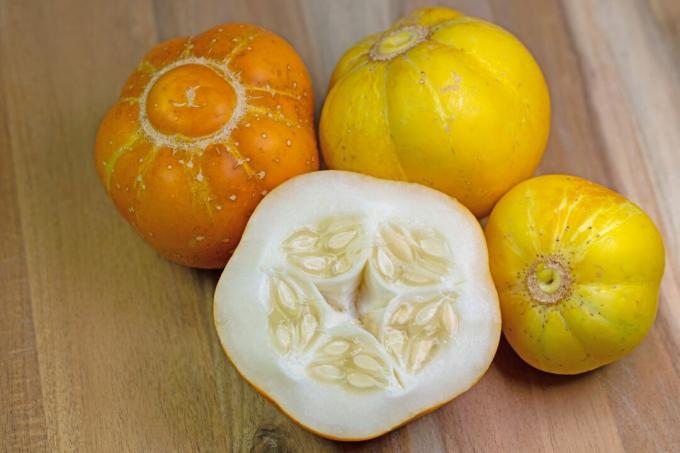
Plant lemon cucumber
The optimal location for the lemon cucumber is warm, sunny and sheltered from the wind. The soil should be loose, permeable and rich in nutrients. The lemon cucumber is a thirsty plant that needs a lot of water. However, it does not tolerate waterlogging. On the balcony, it feels very comfortable as a container plant on the wind-protected wall of the house, as well as in a sunny spot in a raised bed.
From mid-March you can prefer the lemon cucumber. A plant bowl placed on the window sill or in the greenhouse is well suited for this. Ours is recommended as a growing substrate, for example Plantura Organic Herb & Seed Soil. It gives the seeds optimal germination conditions and promotes root growth in the young plants thanks to its loose structure. To sow the lemon cucumber, take 2 to 3 seeds and press them about 2 cm deep into the soil. The seed is then carefully watered. Alternatively, you can sow 2 to 3 seeds at a depth of 2 cm in a pot about 9 cm in diameter. At a temperature of 15 to 20 °C, the seeds will germinate after about 10 days and the first little plants will appear.
The same procedure is followed when sowing directly outdoors from mid-May. In addition, a planting distance of 80 cm should be maintained. In the first few weeks you can cover the seeds with a fleece. Once the cucumbers have developed two real leaves, they are pricked out. The strongest shoot is always left standing, the rest is pulled out.
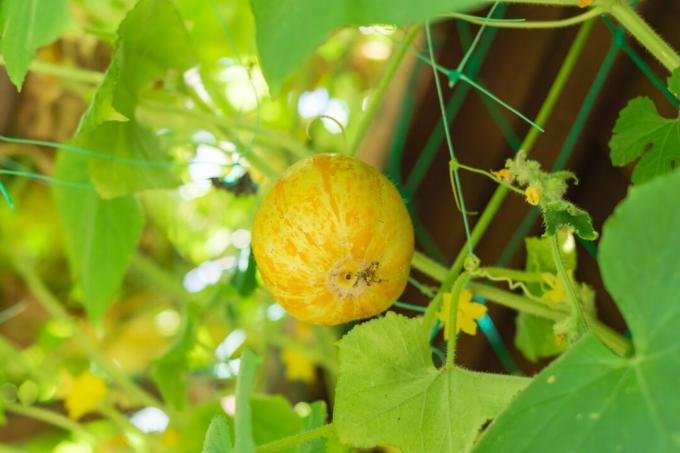
The early seedlings can be planted out at the end of May. Also ensure a planting distance of 80 cm. It is also advisable to upgrade the garden soil with horn shavings and compost. If you would like to cultivate the lemon cucumber as a container plant, ours is suitable, for example Plantura organic tomato & vegetable soil, which is enriched with compost and contains a primarily organic organic fertilizer for a sufficient supply of nutrients to the plants.

Plantura organic tomato & vegetable soil
Organic, peat-free & climate-friendly:
For all types of vegetables and berries,
ensures a rich and aromatic harvest, harmless to humans and animals
Does the lemon cucumber need a climbing aid? The lemon cucumber does not necessarily need a trellis, but can also be cultivated creeping. If you want it to climb up, you should give it a climbing aid after the first tendrils have formed. This can be a trellis, for example, but the lemon cucumber also climbs up the garden fence. This prevents the fruit from lying on the damp surface and starting to mold.
Tip: If the lemon cucumber is to spread on the ground, bark mulch is applied to the ground. This keeps the fruit clean and dry and does not immediately mold.
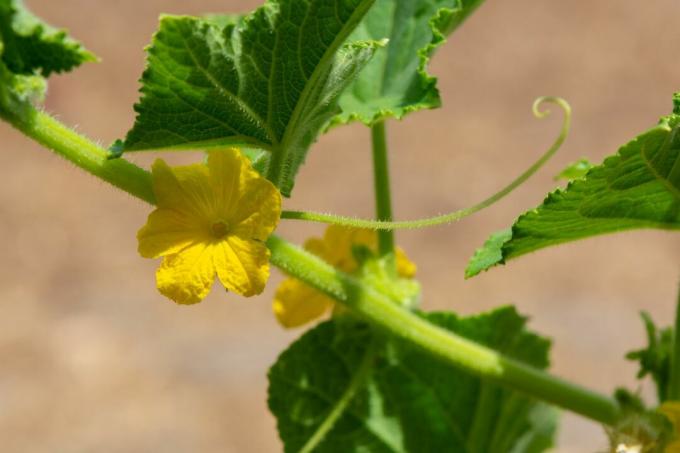
The right care
Growing lemon cucumbers requires some maintenance to ensure a bountiful harvest and protect them from disease.
Fertilize and water
Outdoors, garden soil enriched with compost and horn shavings is sufficient for the nutrient supply. In the case of potted plants, on the other hand, regular fertilization is necessary. For example, our is suitable for this Plantura Organic Tomato & Vegetable Fertilizer. The organic liquid fertilizer can be easily applied with the irrigation water and contains a nutrient ratio that is optimally tailored to vegetables.

Plantura Organic Tomato & Vegetable Fertilizer
Highly effective organic liquid fertilizer
with an NK ratio of 4-5
for all types of vegetables & berries,
safe for pets and garden animals
Lemon cucumbers are thirsty plants, so water them regularly. A lack of water leads to a lower yield for the lemon cucumber. Even the taste leaves a lot to be desired, even bitter fruits can occasionally form. However, the plants are sensitive to wet feet. Be careful to only water the cucumbers from below so that the leaves don't get wet. Diseases tend to settle on wet greens.
Common diseases
Cool temperatures combined with humid conditions quickly lead to disease in the lemon cucumber. Common fungal infections are mildew and Sclerotinia wilt.
For example, cucumber mosaic virus, which is carried by aphids (Aphidoidea) is transmitted, the lemon cucumber to create. This is where yellow or light green, mosaic-like discolouration, deformation and bumps appear on the young leaves. Wilting and low yield are signs of the virus. Cucumbers and other plants showing signs of the mosaic virus should be removed from the garden immediately and disposed of in the household waste - not on the compost. In order to prevent the virus, the carrier, i.e. the aphid, must be kept away from the plant. As Control aphids biologically, you can find out in our special article. In order to generally keep diseases away, it is important to find a suitable location for the lemon cucumber and to avoid constant moisture.
Harvest: when are lemon cucumbers ripe?
Lemon cucumbers are harvested from July to September. You can easily recognize the ripe lemon cucumbers by their lemon-yellow skin. Lemon cucumbers are best in the morning and mid-morning, because they contain fewer bitter substances during this period. Harvest the lemon cucumber as quickly as possible, then the fruits will still be nice and tender. If you stay on the plant for too long, the skin will harden. In addition, the lemon cucumber bears more if you harvest it regularly.
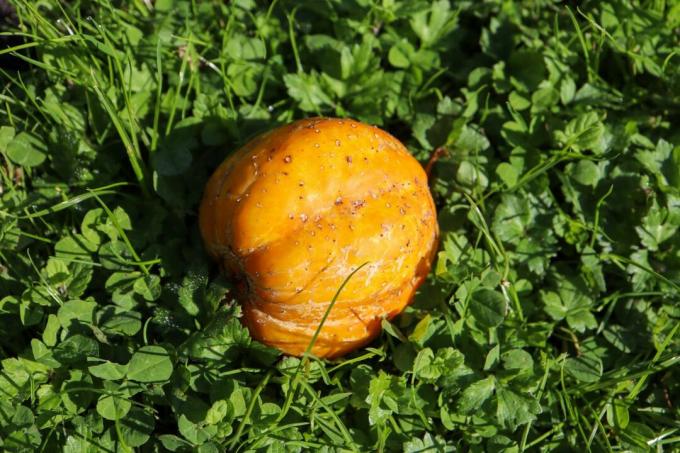
Can you get seeds from the lemon cucumber? Obtaining seeds from the lemon cucumber is rather difficult. Undesirable properties often occur, such as the formation of inedible substances. In this case, it is better to use checked seeds. If you do want to try growing lemon cucumbers from your own seeds, you'll need to plant other cucurbits isolate and pollinate the female flowers by hand, as they are pure cross-pollinators and otherwise easily other cucumber varieties cross in Mark the manually pollinated fruits and let them ripen completely until the cucumber has a hard skin. This is usually the case in late summer. Then the corresponding fruits are harvested and the seeds are obtained. The seeds then have to be dried before they can be stored.
Prepare and peel the lemon cucumber
The lemon cucumber is very versatile. They can be eaten like an apple, although the fruit does not have to be peeled. As with the conventional cucumber, the skin is edible. In salads, the lemon cucumber provides an exotic look and a special taste. For this purpose, it is often sliced and not grated. The lemon cucumber also goes well in smoothies, juices or in a cold cucumber soup.
Tip: The flowers of the lemon cucumber are also edible and can be stuffed, roasted or fried, for example.
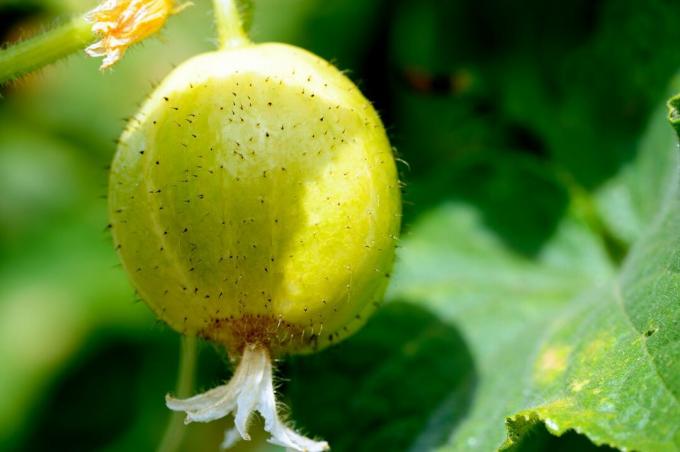
Flavor of Lemon Cucumber
The taste of the lemon cucumber is fresh and fruity. On the one hand it tastes very intensely of cucumber, on the other hand it has a slightly sweet aroma with a sour note. So it tastes just like it looks – exotic.
The lemon cucumber is a versatile plant that will soon conquer our gardens. Another interesting and exotic member of the cucumber genus, the kiwano (Cucumis metuliferus), you will get to know in our special article.
...and receive concentrated plant knowledge and inspiration directly in your e-mail inbox every Sunday!

